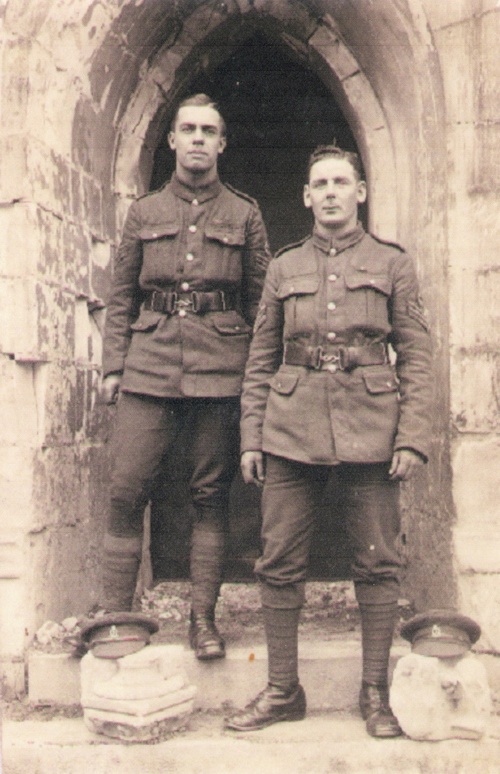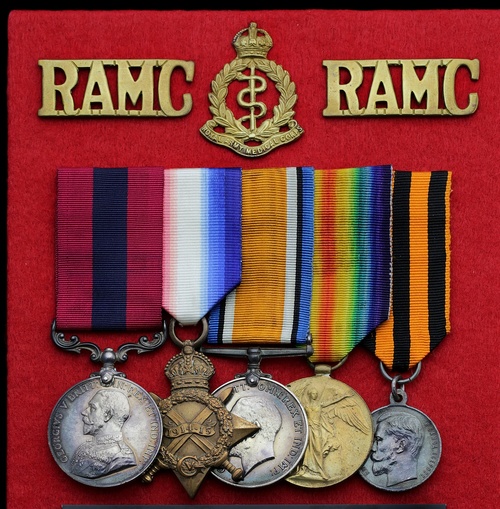Auction: 20001 - Orders, Decorations and Medals - conducted behind closed doors
Lot: 662
The superb 'Hohenzollern Redoubt' D.C.M. group of five to Corporal (Acting Sergeant) S. A. Smith, Royal Army Medical Corps, who was twice decorated for bringing wounded men to safety under heavy fire; a well-loved character, Smith died of wounds received from a German shell and was mourned by family and comrades in equal measure
Distinguished Conduct Medal, G.V.R. (45659 Pte. S. A. Smith 37/F.A. R.A.M.C.); 1914-15 Star (45659. Pte. S. A. Smith. R.A.M.C.); British War and Victory Medals 1914-19 (45659 A.Sjt. S. A. Smith. R.A.M.C.); Russia, Imperial, St. George Medal for Zeal, mounted swing-style and displayed on red velvet, with the recipient's brass shoulder-strap badges and R.A.M.C. cap badge, very fine (5)
D.C.M. London Gazette 15 April 1916:
'For conspicuous devotion to duty. Under heavy fire which prevented the use of stretchers, Private Smith assisted in carrying wounded men to places of safety.'
St. George Medal for Zeal (4th Class) London Gazette 15 February 1917.
Sidney Allen Smith was born in Faversham, Kent in 1894, the son of William and Sarah Smith. The 1911 Census shows him living with his family at Dale Farm Cottages, Hernhill, Kent. He enlisted into the Royal Army Medical Corps at the start of the Great War, serving with 37th Field Ambulance on the Western Front. He arrived in France on 1 June 1915. Smith was decorated for his bravery during the British attack on Hohenzollern Redoubt, a strongpoint of the German 6th Army near Loos, on 2-18 March 1916. As a stretcher-bearer, Smith carried on bringing wounded men to safety even under heavy fire. For this feat he also received the Russian St. George Medal. He developed a close friendship with Sergeant S. McKenna, R.A.M.C., who wrote this heart-breaking letter to Smith's parents on 6 December 1917:
'Dear Mr. & Mrs. Smith,
I am very sorry to be the bearer of this sad news which I expect that you have heard by now. Well dear friends I was with poor Sid when he was wounded and I done all that was possible for him. We were coming down a trench when a shell burst nearby and wounded poor Sid in the left arm and right leg. I bandaged him up and got back to a dressing station with him where he was seen by two doctors who done all they could for him and then they sent him twelve miles behind the line to a C.C.S. where he passed away the next day. I wanted to go and see him but I was too late as they had just buried him. I went to his grave and had the last look at his place of rest. They told me that he was cheerful to the last and had no suffering since he could feel no pain.
I hope you will excuse me for not writing sooner, as I was so much cut up about him as he was my one and only pal. I don't know how I shall go on without him. He was the bravest of the brave and did not know what fear was. Well dear friends I can tell you that he was doing his duty at the time also I can tell you that he was recommended for bravery in the field two days before that fateful day he was one of the best liked men in the whole division by all officers, N.C.O.s and men and I can tell you it was a big blow to us all to lose such a good and faithful friend as he was, he was my one and only pal and you don't know how I have suffered with such a great loss, I can't sleep for thinking of him.'
Smith was wounded on 28 November 1917, and taken to No. 55 Casualty Clearing Station where he died the following day. He is buried in Tincourt New British Cemetery (Section III, Row A, Grave 16); sold with copied MIC, London Gazette entries, copied photographs of the recipient, photocopies of two of Sergeant McKenna's letters to Smith's parents, and a C.W.G.C. booklet containing colour photographs of his grave.
Subject to 20% VAT on Buyer’s Premium. For more information please view Terms and Conditions for Buyers.
Sold for
£1,500
Starting price
£1100







